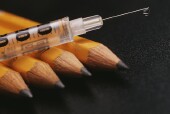
THURSDAY, Sept. 12 (HealthDay News) — Vaccination rates among America’s children remain high, despite a serious resurgence of measles among unvaccinated children and adults, health officials reported Thursday.
According to the 2012 National Immunization Survey, vaccination for many diseases remains at or above 90 percent among children aged 19 months to 35 months, the U.S. Centers for Disease Control and Prevention reported.
“The vast majority of parents are vaccinating their children against potentially serious diseases,” Dr. Anne Schuchat, director of the CDC’s National Center for Immunization and Respiratory Diseases, said during a noon press briefing Thursday.
“The high vaccine coverage we are seeing explains why most vaccine-preventable diseases are at record-low levels,” she said.
As of Aug. 24, however, the CDC knew of 159 cases of measles this year, Schuchat said. “That’s the second largest number of measles cases we’ve had in this country since measles was eliminated in 2000,” she added.
Three outbreaks account for most of this year’s cases — 65 cases in New York (mostly in New York City), 23 in North Carolina and 20 in Texas. The highly contagious viral disease has been spotted in 16 states, affecting newborns through senior citizens. Thirty-six percent of patients were younger than 5 years, and 11 percent younger than 1 year — too young to be vaccinated. No deaths have been reported this year, Schuchat said.
Most cases were among unvaccinated people or those whose vaccination status was unknown.
According to the new data, which was published Sept. 13 in the CDC’s Morbidity and Mortality Weekly Report, the vaccination rate among children born between 2009 and May 2011 for measles, mumps and rubella (MMR) was nearly 91 percent; for polio, about 93 percent; and for hepatitis B and varicella/chickenpox, about 90 percent.
Coverage was lower for diphtheria, tetanus and pertussis (DTaP), at 83 percent; the full series of Haemophilus influenzae (Hib), at 81 percent; and four doses of pneumococcal conjugate vaccine (PCV), at less than 82 percent.
Only 53 percent of children were vaccinated against hepatitis A and just 69 percent had the rotavirus vaccine, according to the data.
Schuchat said PCV and DTaP booster shots are essential at age 2, and far too few children get them. DTaP protects against whooping cough.
“[Still], the percentage of children who get no vaccines remains low,” Schuchat said. “Only 0.8 percent of children in the survey had received no vaccines at all.”
Among the unvaccinated, 79 percent had philosophical objections to the vaccine. Typically, these objections concern fears about vaccine safety or adherence to religious beliefs. Theories that vaccines can lead to autism, however, have been widely discounted by scientists.
“Clusters of people with like-minded beliefs leading them to forgo vaccines can be susceptible to outbreaks when measles virus is imported,” Schuchat said.
The Vaccines for Children Program, launched in 1993 to rectify a crisis of missed opportunities, makes vaccines available to most children and is credited with the high rates of vaccine coverage among America’s children.
Today’s local measles outbreaks represent a very different dynamic, Schuchat said. “Instead of our system missing opportunities to vaccinate young children, in some communities, people have been rejecting opportunities to be vaccinated,” she said.
The national measles outbreak of 1989 to ’91 that led to the creation of the Vaccines for Children Program was deadly. “During those years, about 55,000 cases of measles were reported in the United States, and 123 people died from measles,” Schuchat said. “Hardest hit were unvaccinated preschool-aged children.”
The current measles outbreaks aren’t at the crisis level of 1989, but that could change quickly, Schuchat said.
Measles is common around the world, and continues to be imported to the United States, posing a threat to unvaccinated people. “All of the cases of measles reported in the United States in 2013 were associated with importations from other countries,” Schuchat said. “Half of these cases originated from Europe.”
The CDC recommends that children get a measles/mumps/rubella vaccine at 12 months and again at 4 to 6 years of age.
More information
For more information on vaccines, visit the U.S. Centers for Disease Control and Prevention.
Copyright © 2025 HealthDay. All rights reserved.

